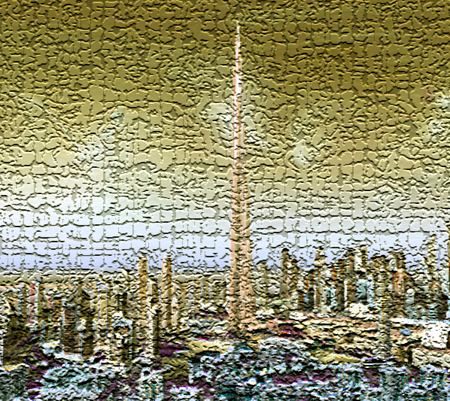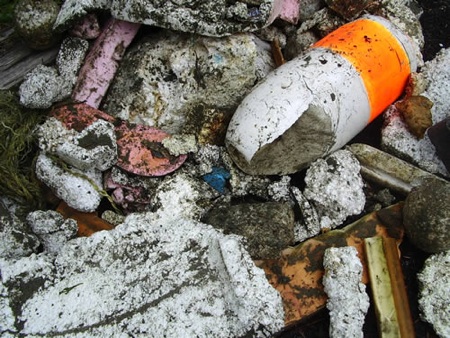Fossil Cities
There seems to be three stages in the physical formation of a planet’s composition; in each stage the majority its minerals are shaped by a new, additional force. Those three forces are: physics, life, and mind.
The physical influence on minerals is obvious. Until recently physics was seen as the only force in geology. Chemical reactions, heat, erosion, immense weight and pressure, and occasionally atomic forces all conspire to shape and reshape rocks. What more could happen?
Recent studies suggest that most minerals present on earth today were directly or indirectly shaped by life, that wavering intangible thing. Life altered the atmosphere, the chemical environment underground, and in bulk life created the ingredients for new types of rock like shale and limestone, and indirectly altered climate, weathering, erosion, all of which generated thousands of new types of minerals. The strongest proponents of the related Gaia Hypothesis suggest that life maintains the chemical composition of the planet in a persistent non-equilibrial state, a distinctive signature that could be detected a million miles away.
With the rise of human minds, and the widespread emergence of technology, a third geological era is arriving: the Anthropocene. Geologically, this era is not finished being born yet since it is only a few hundred years old; now is more like the moment of conception. But even in this brief flash we can see how vastly the technium has altered the planet. Sprawling megacities cover tens of thousands of square kilometers. Each city is built out of vast quantities of minerals mined from the earth. All the metal, brick, glass and stone in these megaliths has been manufactured from mind and earth. And all of this transformed mineral will eventually — someday or other — return to the earth, to be reprocessed into new minerals.
A new book by Jan Zalasiewicz, a geologist from the University of Leicester, “The Earth After Us: What Legacy Will Humans Leave in the Rocks?”, catalogs how cities — and the products of the technium — might be fossilized. It’s a wonderful scenario exercise. He outlines possible geologic pathways for the major building components of our technological civilization.

The mass and bulk of the cities and suburbs erected over vast tracks of earth are primarily made from bricks, glass, concrete, pressed earth, and stone, with some metal bones. All of these have natural analogs. Brick is fired clay, which is often found in nature as mudrock — clay heated by hot magna. Concrete is sand and gravel glued with limestone; such aggregates are also found in nature. Glass is obsidian. And occasionally pure metals are found as nuggets. Geologists can see how these natural minerals age over millions of years; Zalasiewicz suggests our building materials will age similarly.
Firing a brick drives off the water. Once in a wall and exposed to the elements the brick will absorb water, and expand: only by a fraction of a per cent, but, over time, sometimes enough to fracture it, especially if hard cement-based mortar is used in construction (rather than softer lime-based mortar that can better absorb the expansive stresses). This expansion can carry on for thousands of years (it has been observed for Roman bricks) albeit at progressively slower rates. Nevertheless, once in the burial realm and permanently waterlogged, the bricks of the Urban Stratum will expand to an effective maximum, and the stresses involved may break many of them.
The red colour of many bricks is due to oxidation during firing on long-term burial this should reverse, with fossil bricks reverting to the greys and blues of the original raw material. With ever-deeper burial, the tiny, highly reactive flakes of clay mineral within the original bricks will change their structure, recrystallize, eventually transforming into larger (but still microscopic) crystals of different clay minerals; as yet higher temperatures are attained, these clay crystals begin to transform into mica. Yet-and here is the bottom line-these brick fossils, and the concrete fragments lying next to them, should still be recognizable as artefacts.
Regrettably, none of these ideas have been tested. I had a chance to speak to Zalasiewicz once, and was surprised to find out from him that there is very little work in synthetically producing accelerated fossils from modern materials. No one has been trying to fossilize construction rubble, plastic water bottles, and junk car parts. In fact, few are trying to recreate accelerated fossilization of natural materials either.
We do know that oxygen, water, and weather are incredibly corrosive, reducing everything to very base, inert, stable materials.
Of other metals,copper and zinc are more soluble and mobile than, say, lead. In fossilization, therefore, the electrical wiring could well disappear while the plumbing remains.
The most sophisticated technological materials are unlikely to survive, except in the negative form. But much of our manufactured landscape is made of geological old materials in the first place.
Each of us humans (in the developed world, at least) on average, in our lifetime, uses some 500 tons of sand and gravel, plus limestone, brick clay, and asphalt. From these we create our roads, houses, and foundations, schools, hospitals, restaurants, and multiplex cinemas. Together with the iron, steel, copper, plastic, this can, over the human generations and the centuries, pile up to form a great mass of material, for new houses tend to be constructed upon the rubble of the old. In urban areas the accumulated rubble of centuries of building forms a significant geological deposit. On geological maps it is often termed ‘Made Ground’. For the purposes of this narrative, let us call it the Urban Stratum. In old, well-established cities it can be tens of metres thick, and in cities such as New Orleans, the pilings that keep the skyscrapers safely scraping sky additionally form a kind of subterranean inverted forest of concrete.
While these huge piles of rubble build up as humans tear old structures down and rebuild on top (which is why archeological sites of old cities rise above their surroundings), the rubble on top is chaotic. The real patterns are below:
The deep skyscraper roots form inverted concrete and steel spires beneath a New Orleans that is slowly sinking into the Gulf of Mexico, as the detritus of half a continent, washed on to the top of the Mississippi delta, presses down on the malleable crust. Around the tops of the concrete piles snake the thick tangle of pipes for water, electricity, gas, sewage, optical cables, of subways, underground carparks, and nuclear fall-out shelters. Once in the burial realm, these abandoned foundations of our human empire can begin their transformation into the Urban Stratum that may, in the yet more distant future, be discovered, analysed, explored, marvelled at.
Not all cities will fossilized, just as not all dead animals will. The conditions must be right.
What city? It might be New Orleans, or Haiphong, or Shanghai, or Amsterdam, or Venice, or Port Harcourt, or Dhaka. These are just a few of the cities and megacities that today spread across coastal plains, and over river floodplains and estuary margins. These, hence, are firmly sited on downgoing tectonic escalators, the weight of the deltaic sediment that they are built on inexorably dragging them down. And all are at or just above sea level (or just below it, in some cases, behind protective walls), so making them vulnerable to drowning by even the slightest of sea level rises. Once drowned, they will be removed from the realm of erosion into the realm of
sedimentation, as if placed in a pickling jar.
Other cities on higher erosion planes, or on the leading edges of uplift, like San Francisco will not be candidates for hundreds of millions of years. When cities fossilized, the finer pieces of their technium can occasionally be preserved, just as we might sometimes find fossils of delicate flowers. So will our iPhones and carbon-fiber skis make it to the next geological era? There is some hope a few will, but they will have undergone massive transformations.
A pollen grain, on being ever more deeply buried, changes colour from its original pale translucency, through progressively darker shades of straw-yellow to orange to brown, eventually turning to the opaque black of the graphitized carbon shell it finally becomes. This colour change is so predictable that it has become, for modern paleontologists and petroleum geologists, a kind of palaeo-thermometer for strata, that tells them how much burial and how much heating they have experienced. At least some of the human-manufactured plastic artefacts, in the millions of years to come, should undergo a similar colour transformation, and strata-encased plastic cups and shampoo bottles will have forever lost their pristine transparency. It is a useful colour series, this, one of the chief clues to another transformation: the underground creation of oil.
What might be the best fossil analogues for, say, a polystyrene cup? Perhaps some of the long-chain organic molecules in the organic skeletons of some marine invertebrates.

One may predict a range of fossilized plastic tubes and bottles among the Urban Strata, varying in colour from pale yellow to brown to black, depending on how deeply they were buried. Other plastics might, under heat and pressure, break down completely into their component molecules, which migrate up through the rock strata until they are trapped by some impermeable rock layer, to become a minute fraction of newly forming oil and gas reserves.
It is likely that artificial glasses will, over time, likewise transform and lose their transparency. Jam-hars and milk bottles and window shards, one hundred million years from now, will almost all be milky-white, opaque.
Many fossil remains are new materials filling a hole or mold made by the original. We can imagine a similar casting process for technological items as they become buried under sediment and compressed by thousands of feet of new rock. Curiously they won’t necessarily be deformed by the pressure.
Such differences in compaction are commonplace in buried strata, of whatever age. Individual buried ripples or dunes of sand, encased within mud, will retain much of their shape as the compressible mudrock slowly deforms around them. Yet still, any objects within those spaces — abandoned furniture, cups and saucers, machinery of whatever sort — will be spared from crushing, and will — at least physically — retain their three-dimensional shapes.
Wherever cities are buried in mud, pyritization will take place. What might the fossil-equivalents be? Small part-empty plastic containers, perhaps, and sections of plastic tubing and wire. The surfaces of fragments of cup and flowerpot. The interiors of any of the myriads of tiny metal and electronic gadgets that we now produce in their millions also seem to be good candidates for such sulphidic coating and infill, for these in themselves contain iron, one of the ingredients of pyrite [fools gold]. Part of the detritus of human civilization will certainly bear the sheen of fool’s gold.
The mind of the technium will not only transform our lives, but in the goodness of geological time, it will breed new minerals and a transformed earth. In other words, the technium will geo-engineer even after we depart. It will continue to shape the planet with or without us.


